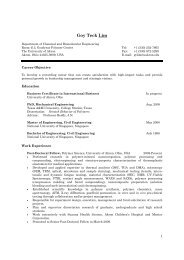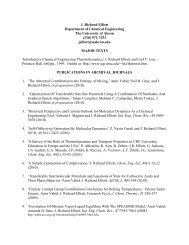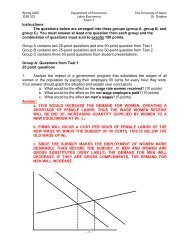Sociology of the Anarchists - Gozips.uakron.edu - The University of ...
Sociology of the Anarchists - Gozips.uakron.edu - The University of ...
Sociology of the Anarchists - Gozips.uakron.edu - The University of ...
You also want an ePaper? Increase the reach of your titles
YUMPU automatically turns print PDFs into web optimized ePapers that Google loves.
International Monetary Fund (IMF). 20<br />
Critical <strong>the</strong>ory says that conflict is not in <strong>the</strong> realm <strong>of</strong> resources, but in <strong>the</strong> realm <strong>of</strong><br />
culture and ideas. Anarchism appears to be somewhat sympa<strong>the</strong>tic to this view, too, since<br />
<strong>the</strong> quest to overcome oppressive ideologies (and replace <strong>the</strong>m with freedom) is a battle<br />
<strong>of</strong> ideas, i.e. is socialism more just than capitalism, can egalitarian families be constructed<br />
minus patriarchy, etc.? <strong>The</strong> “oppression” <strong>of</strong> rationalization kills our creativity, says<br />
critical <strong>the</strong>ory, and anarchist would likely say similar things (<strong>the</strong> Machiavellian quest for<br />
economic efficiency is detrimental to creative and liberating social relations).<br />
Georg Simmel's conflict <strong>the</strong>ory <strong>of</strong> sociation does not address inequality, but abstract<br />
forms. He says society is patterned interactions, in which humans interact with each o<strong>the</strong>r<br />
in patterns that exist on <strong>the</strong> level <strong>of</strong> individuals or nations. Simmel focused on <strong>the</strong><br />
patterns <strong>of</strong> interactions not <strong>the</strong> content itself. This can be applied to network <strong>the</strong>ory<br />
(where parties interact with each o<strong>the</strong>r in huge spiderwebs <strong>of</strong> connections). <strong>The</strong>re is a<br />
distinction between strong and weak ties. A close tie is an intimate or family connection,<br />
while weak ties are acquaintance connections. This difference would be useful for<br />
anarchists (and o<strong>the</strong>r leftists) to understand why <strong>the</strong> same people get recycled through<br />
<strong>the</strong>ir movements (via only strong connections). Weak connections (ties to outside groups)<br />
gives access to more information and thus more possibility for movement building—a<br />
fancy way <strong>of</strong> repeating <strong>the</strong> old adage: “don't preach to <strong>the</strong> choir”. Thus, each sociation has<br />
both positive and negative aspects: fighting and arguing over something (such as political<br />
views or values) is negative, but <strong>the</strong> fact that it is important enough to fight over is<br />
positive (according to Simmel's thinking).<br />
Simmel also distinguishes between conflict and competition: conflict requires <strong>the</strong> defeat<br />
<strong>of</strong> an opponent to achieve a goal, while competition is parallel efforts by opponents to<br />
achieve <strong>the</strong> same goal, but <strong>the</strong> defeat <strong>of</strong> <strong>the</strong> opponent does not mean you are successful in<br />
completing your goal. This is a useful lens for <strong>the</strong> direct action movement to consider:<br />
does locking down a street for an hour or two accomplish a goal, even though <strong>the</strong><br />
opponent (police, <strong>the</strong> city, conference delegates, “<strong>the</strong> system”) is temporarily beat?<br />
According to Simmel, such things are not true conflict, but ra<strong>the</strong>r competition (in this<br />
example, competition for control over city streets or access, but not conflict that<br />
challenges/changes existing power relations). Perhaps a corollary to this <strong>the</strong>ory might be<br />
to say that competition can be channeled into conflict (via social revolution)?<br />
Concepts <strong>of</strong> conflict resolution can be derived from Simmel. First, inter-group conflict<br />
between group members can lead to factions, something all anarchists know about due to<br />
<strong>the</strong> strong feelings many anarchists have about things. In recent years, <strong>the</strong>re has been<br />
much contention within anarchist organizations about issues <strong>of</strong> racism, sexism,<br />
homophobia, etc. <strong>The</strong> “APOC” (anarchist people <strong>of</strong> color) movement has been very<br />
encouraging in one <strong>of</strong> <strong>the</strong>se respects—collectives and conferences are occurring in many<br />
parts <strong>of</strong> <strong>the</strong> US now.<br />
External threats, in <strong>the</strong> form <strong>of</strong> common enemies can unify factions and r<strong>edu</strong>ce internal<br />
20 Including o<strong>the</strong>r neo-colonist organizations and schemes: TABD, APEC, WEF, NAFTA, FTAA, MAI,<br />
and o<strong>the</strong>r alphabet soup acronyms.<br />
[ Williams 21 ] [ this is a draft. do not cite. ]






